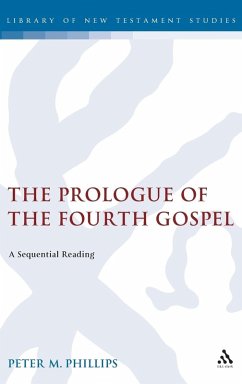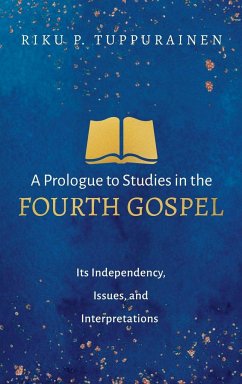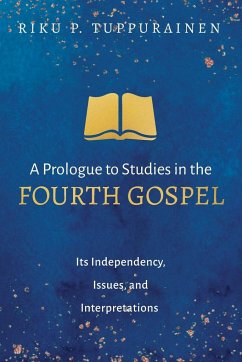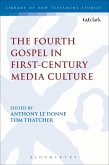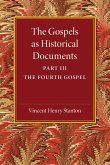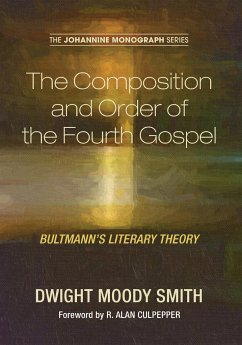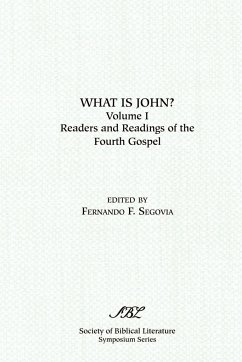- Gebundenes Buch
- Merkliste
- Auf die Merkliste
- Bewerten Bewerten
- Teilen
- Produkt teilen
- Produkterinnerung
- Produkterinnerung
Phillips undertakes a sequential reading of the Prologue of John's Gospel. By using the reading strategies of Iser, Emmott, and Eco, the book establishes a reading strategy termed sequential disclosure, which is then applied to the text. In order to arrive at the reading, preliminary chapters focus both on historical interpretation of the Prologue in terms of reader response and on the role of the author, the use of persuasion and the development of irony. Special focus is given to the role of the dramatic prologue, as well as the interaction between rhetoric, irony and community. As such, the…mehr
Andere Kunden interessierten sich auch für
![A Prologue to Studies in the Fourth Gospel A Prologue to Studies in the Fourth Gospel]() Riku P. TuppurainenA Prologue to Studies in the Fourth Gospel48,99 €
Riku P. TuppurainenA Prologue to Studies in the Fourth Gospel48,99 €![A Prologue to Studies in the Fourth Gospel A Prologue to Studies in the Fourth Gospel]() Riku P. TuppurainenA Prologue to Studies in the Fourth Gospel36,99 €
Riku P. TuppurainenA Prologue to Studies in the Fourth Gospel36,99 €![The Fourth Gospel in First-Century Media Culture The Fourth Gospel in First-Century Media Culture]() Le Donne AnthonyThe Fourth Gospel in First-Century Media Culture50,99 €
Le Donne AnthonyThe Fourth Gospel in First-Century Media Culture50,99 €![The Fourth Gospel in First-Century Media Culture The Fourth Gospel in First-Century Media Culture]() Tom ThatcherThe Fourth Gospel in First-Century Media Culture179,99 €
Tom ThatcherThe Fourth Gospel in First-Century Media Culture179,99 €![The Gospels as Historical Documents, Part 3, the Fourth Gospel The Gospels as Historical Documents, Part 3, the Fourth Gospel]() Vincent Henry StantonThe Gospels as Historical Documents, Part 3, the Fourth Gospel44,99 €
Vincent Henry StantonThe Gospels as Historical Documents, Part 3, the Fourth Gospel44,99 €![The Composition and Order of the Fourth Gospel The Composition and Order of the Fourth Gospel]() Dwight Moody SmithThe Composition and Order of the Fourth Gospel33,99 €
Dwight Moody SmithThe Composition and Order of the Fourth Gospel33,99 €![What is John? Readers and Readings in the Fourth Gospel, Vol. 1 What is John? Readers and Readings in the Fourth Gospel, Vol. 1]() What is John? Readers and Readings in the Fourth Gospel, Vol. 134,99 €
What is John? Readers and Readings in the Fourth Gospel, Vol. 134,99 €-
-
-
Phillips undertakes a sequential reading of the Prologue of John's Gospel. By using the reading strategies of Iser, Emmott, and Eco, the book establishes a reading strategy termed sequential disclosure, which is then applied to the text. In order to arrive at the reading, preliminary chapters focus both on historical interpretation of the Prologue in terms of reader response and on the role of the author, the use of persuasion and the development of irony. Special focus is given to the role of the dramatic prologue, as well as the interaction between rhetoric, irony and community. As such, the book discusses the role of the reading process in developing a specific community language. The book focuses on the didactic role of the Prologue in teaching readers this language and so including them into the Johannine community. The reading of the Prologue highlights the key aspects of the reading process: ambiguity and disambiguation; resemanticization; antilanguage; community development and intertextuality. A sequential reading of the Prologue highlights the didactic and evangelistic role of this text. JSNTS 294
Produktdetails
- Produktdetails
- Verlag: Bloomsbury 3PL
- Seitenzahl: 280
- Erscheinungstermin: 16. Februar 2006
- Englisch
- Abmessung: 240mm x 161mm x 20mm
- Gewicht: 587g
- ISBN-13: 9780567030658
- ISBN-10: 0567030652
- Artikelnr.: 21356171
- Herstellerkennzeichnung
- Libri GmbH
- Europaallee 1
- 36244 Bad Hersfeld
- gpsr@libri.de
- Verlag: Bloomsbury 3PL
- Seitenzahl: 280
- Erscheinungstermin: 16. Februar 2006
- Englisch
- Abmessung: 240mm x 161mm x 20mm
- Gewicht: 587g
- ISBN-13: 9780567030658
- ISBN-10: 0567030652
- Artikelnr.: 21356171
- Herstellerkennzeichnung
- Libri GmbH
- Europaallee 1
- 36244 Bad Hersfeld
- gpsr@libri.de
Reverend Dr Peter Phillips is New Testament Lecturer at Cliff College, Derbyshire and Honorary Research Fellow at Manchester University.
Chapter One: Introduction 1.1Introductory Comments 1.2Thresholds, Temples
and Pompeii 1.3The Beginning as Threshold 1.4The Reader at the Threshold
1.5The Author at the Threshold 1.6Genette, Paratextuality and the Prologue
1.7Malbon's Three Functions of Gospel Beginnings 1.7.1The Interactional
Function 1.7.2The Intertextual Function 1.7.3The Intratextual Function
1.8Thresholds and Welcome Chapter Two: John's Prologue and Literary Theory
2.1Introductory Comments 2.1.1John's Prologue and Literary Theory
2.1.2John's Prologue and 'Rhetoric' 2.1.3John's Prologue and
Sociolinguistics 2.1.4One Methodology: Three Languages - Sequential
Disclosure 2.2John's Prologue and Literary Theory 2.2.1Anatomy of the
Fourth Gospel 2.2.2The Print's First Kiss 2.2.3Excursus on Paragrammatic
Reading 2.2.4Back to The Print's First Kiss 2.3The Role of the Reader and
the Act of Reading 2.3.1Wolfgang Iser's Phenomenological Approach to
Reading 2.3.2Sequential Disclosure and Sequential Reading 2.3.3Sequential
Disclosure in Catherine Emmott's Narrative Comprehension 2.3.4Sequential
Disclosure in Eco's Theory of 'Interpretative Co-operation' 2.4From Theory
to Practice? 2.4.1Stephen Moore on Sustained Interpretations 2.4.2Sternberg
on David and Bathsheba 2.5The Role of Ambiguity in Sequential Disclosure
2.6Who, then, is the Reader? 2.7Sequential Reading and Educating Readers
2.8Conclusion Chapter Three: John's Prologue and Rhetoric 3.1John's
Prologue and Rhetoric 3.2Rhetoric as the Art of Persuasion 3.3Rhetoric and
Point of View 3.4Rhetoric as Author-Centred, Audience-Orientated
3.5Rhetoric and the Prologue 3.6The Prologue and the Prooimion
3.6.1Aristotle and the Prooimion 3.6.2The Dramatic Prologue 3.6.3The
Didactic Role of Dramatic Prologues 3.6.4The Prooimion and the Prologue
3.6.5Prooimion or Prologue: Neither or Both? 3.7Repetitio 3.7.1Repetitio
and the Prologue 3.7.2The Effect of Repetitio in the Prologue - a Spiral
Structure? 3.7.3The Role of Repetition and Spiral Structure for the Reader
3.8The Prologue and Irony 3.8.1Irony in Ancient Rhetoric 3.8.2Irony in
Greek Drama 3.8.3Irony as Invitation 3.9Conclusion Chapter Four: John's
Prologue and Sociolinguistics 4.1Introduction 4.2Meeks and Johannine
Sectarianism 4.3Beyond Meeks 4.4Petersen and Antilanguage 4.4.1The
Johannine Community, Antisociety and Antilanguage 4.4.2The Functions and
Setting of Antilanguage 4.4.3Halliday and Antilanguage 4.4.4Schniedewind
and Qumranic Hebrew as an Antilanguage 4.4.5Johannine Language as an
Antilanguage? 4.4.6A Johannine Antilanguage 4.4.7Antilanguage to Semantic
Shift 4.5Semantics 4.5.1Wierzbicka and Conceptual Synonymy 4.5.2Specific
Meanings developed for Specific Contexts 4.5.3Semantic Shift and the Gospel
of John 4.5.4Semantic Shift and Sequential Disclosure 4.6Speech
Accommodation Theory (SAT) 4.6.1Malina and SAT 4.6.2SAT as Intergroup or
Intragroup Dynamic? 4.6.3SAT - another look 4.6.4Valentinian Exegesis as
Outgroup Divergence 4.6.5The Prologue as Outgroup Convergence 4.7Conclusion
Chapter Five: The Logos 5.1Introduction 5.2Intertextuality Again 5.3A Way
Forward? 5.4General Greek Usage - the Lexica 5.5Christian Intertexts
5.5.1In the Gospels in General 5.5.2In the Johannine Literature
5.5.3Elsewhere in the New Testament 5.5.4Some Preliminary Conclusions
5.5.6Non-Canonical Christian Literature - The Odes 5.6Hellenistic
Intertexts 5.6.1Heraclitus 5.6.1.1Heraclitus and Logos 5.6.1.2Heraclitus or
a Stoic Heraclitus 5.6.1.3Heraclitus and a Logos Doctrine? 5.6.1.4Ambiguity
in Heraclitean and Johannine Literature 5.6.2The Stoics 5.6.2.1The Stoics
and Logos 5.6.2.2The Stoic Logos and the Prologue 5.6.3Gnostic/Hermetic
Material 5.6.3.1Intertextual Possibilities in The Corpus Hermeticum
5.6.3.2The Corpus Hermeticum 5.6.3.3The Poimandres 5.6.3.4Hermeticism and
the Prologue 5.6.3.5Introductory Comments to the Gnostic Texts 5.6.3.6The
Tripartite Tractate 5.6.3.7The Gospel of Truth 5.6.3.8The Trimorphic
Protennoia 5.6.3.9Gnostic and Hermetic Texts and the Prologue 5.7A
Hellenistic-Jewish Intertext - Philo of Alexandria 5.7.1Introductory
Comments 5.7.2Philo and logos 5.7.3Dodd, Plato and Philo 5.7.4Philo and the
Prologue 5.8Other Jewish Intertexts 5.8.1The Word of God in the Hebrew
Bible 5.8.1.1The Word of God 5.8.1.2Metaphor or Being? 5.8.1.3Lo/goj in the
Septuagint and the Prologue 5.8.2The Sapiential Tradition 5.8.2.1Wisdom
5.8.2.2Available or Remote Wisdom? 5.8.2.3Scott's Sophia and the Johannine
Jesus 5.8.2.4The Prologue as Re-interpretation 5.8.2.5Wisdom: A Conclusion?
5.8.3Torah Speculation 5.8.3.1Wisdom, Word and Torah 5.8.3.2The Prologue
and Torah 5.9Conclusion 5.9.1Parallels without a doubt? 5.9.2Parallels or
Echoes? 5.9.3The Prologue and Learning How to Read 5.9.4The Logos as Jesus
5.9.5Exit the Logos - Enter Jesus Chapter Six: A Reading of the Prologue
6.1Introduction 6.2Verse 1a 6.3Verse 1b,c 6.4Verse 2 6.5Verse 3a,b 6.6Verse
3c, 4 6.7Verse 5 6.8Verse 6 6.9Verse 7 6.10Verse 8 6.11Verse 9 6.12Verse 10
6.13Verse 11 6.14Verse 12 6.15Verse 13 6.16Verse 14a 6.17Verse 14b
6.18Verse 14c 6.19Verse 15 6.20Verse 16 6.21Verse 17 6.22Verse 18 Chapter
Seven: Conclusion Bibliography Appendix A: Logos: Some Quotations from
Classical Texts
and Pompeii 1.3The Beginning as Threshold 1.4The Reader at the Threshold
1.5The Author at the Threshold 1.6Genette, Paratextuality and the Prologue
1.7Malbon's Three Functions of Gospel Beginnings 1.7.1The Interactional
Function 1.7.2The Intertextual Function 1.7.3The Intratextual Function
1.8Thresholds and Welcome Chapter Two: John's Prologue and Literary Theory
2.1Introductory Comments 2.1.1John's Prologue and Literary Theory
2.1.2John's Prologue and 'Rhetoric' 2.1.3John's Prologue and
Sociolinguistics 2.1.4One Methodology: Three Languages - Sequential
Disclosure 2.2John's Prologue and Literary Theory 2.2.1Anatomy of the
Fourth Gospel 2.2.2The Print's First Kiss 2.2.3Excursus on Paragrammatic
Reading 2.2.4Back to The Print's First Kiss 2.3The Role of the Reader and
the Act of Reading 2.3.1Wolfgang Iser's Phenomenological Approach to
Reading 2.3.2Sequential Disclosure and Sequential Reading 2.3.3Sequential
Disclosure in Catherine Emmott's Narrative Comprehension 2.3.4Sequential
Disclosure in Eco's Theory of 'Interpretative Co-operation' 2.4From Theory
to Practice? 2.4.1Stephen Moore on Sustained Interpretations 2.4.2Sternberg
on David and Bathsheba 2.5The Role of Ambiguity in Sequential Disclosure
2.6Who, then, is the Reader? 2.7Sequential Reading and Educating Readers
2.8Conclusion Chapter Three: John's Prologue and Rhetoric 3.1John's
Prologue and Rhetoric 3.2Rhetoric as the Art of Persuasion 3.3Rhetoric and
Point of View 3.4Rhetoric as Author-Centred, Audience-Orientated
3.5Rhetoric and the Prologue 3.6The Prologue and the Prooimion
3.6.1Aristotle and the Prooimion 3.6.2The Dramatic Prologue 3.6.3The
Didactic Role of Dramatic Prologues 3.6.4The Prooimion and the Prologue
3.6.5Prooimion or Prologue: Neither or Both? 3.7Repetitio 3.7.1Repetitio
and the Prologue 3.7.2The Effect of Repetitio in the Prologue - a Spiral
Structure? 3.7.3The Role of Repetition and Spiral Structure for the Reader
3.8The Prologue and Irony 3.8.1Irony in Ancient Rhetoric 3.8.2Irony in
Greek Drama 3.8.3Irony as Invitation 3.9Conclusion Chapter Four: John's
Prologue and Sociolinguistics 4.1Introduction 4.2Meeks and Johannine
Sectarianism 4.3Beyond Meeks 4.4Petersen and Antilanguage 4.4.1The
Johannine Community, Antisociety and Antilanguage 4.4.2The Functions and
Setting of Antilanguage 4.4.3Halliday and Antilanguage 4.4.4Schniedewind
and Qumranic Hebrew as an Antilanguage 4.4.5Johannine Language as an
Antilanguage? 4.4.6A Johannine Antilanguage 4.4.7Antilanguage to Semantic
Shift 4.5Semantics 4.5.1Wierzbicka and Conceptual Synonymy 4.5.2Specific
Meanings developed for Specific Contexts 4.5.3Semantic Shift and the Gospel
of John 4.5.4Semantic Shift and Sequential Disclosure 4.6Speech
Accommodation Theory (SAT) 4.6.1Malina and SAT 4.6.2SAT as Intergroup or
Intragroup Dynamic? 4.6.3SAT - another look 4.6.4Valentinian Exegesis as
Outgroup Divergence 4.6.5The Prologue as Outgroup Convergence 4.7Conclusion
Chapter Five: The Logos 5.1Introduction 5.2Intertextuality Again 5.3A Way
Forward? 5.4General Greek Usage - the Lexica 5.5Christian Intertexts
5.5.1In the Gospels in General 5.5.2In the Johannine Literature
5.5.3Elsewhere in the New Testament 5.5.4Some Preliminary Conclusions
5.5.6Non-Canonical Christian Literature - The Odes 5.6Hellenistic
Intertexts 5.6.1Heraclitus 5.6.1.1Heraclitus and Logos 5.6.1.2Heraclitus or
a Stoic Heraclitus 5.6.1.3Heraclitus and a Logos Doctrine? 5.6.1.4Ambiguity
in Heraclitean and Johannine Literature 5.6.2The Stoics 5.6.2.1The Stoics
and Logos 5.6.2.2The Stoic Logos and the Prologue 5.6.3Gnostic/Hermetic
Material 5.6.3.1Intertextual Possibilities in The Corpus Hermeticum
5.6.3.2The Corpus Hermeticum 5.6.3.3The Poimandres 5.6.3.4Hermeticism and
the Prologue 5.6.3.5Introductory Comments to the Gnostic Texts 5.6.3.6The
Tripartite Tractate 5.6.3.7The Gospel of Truth 5.6.3.8The Trimorphic
Protennoia 5.6.3.9Gnostic and Hermetic Texts and the Prologue 5.7A
Hellenistic-Jewish Intertext - Philo of Alexandria 5.7.1Introductory
Comments 5.7.2Philo and logos 5.7.3Dodd, Plato and Philo 5.7.4Philo and the
Prologue 5.8Other Jewish Intertexts 5.8.1The Word of God in the Hebrew
Bible 5.8.1.1The Word of God 5.8.1.2Metaphor or Being? 5.8.1.3Lo/goj in the
Septuagint and the Prologue 5.8.2The Sapiential Tradition 5.8.2.1Wisdom
5.8.2.2Available or Remote Wisdom? 5.8.2.3Scott's Sophia and the Johannine
Jesus 5.8.2.4The Prologue as Re-interpretation 5.8.2.5Wisdom: A Conclusion?
5.8.3Torah Speculation 5.8.3.1Wisdom, Word and Torah 5.8.3.2The Prologue
and Torah 5.9Conclusion 5.9.1Parallels without a doubt? 5.9.2Parallels or
Echoes? 5.9.3The Prologue and Learning How to Read 5.9.4The Logos as Jesus
5.9.5Exit the Logos - Enter Jesus Chapter Six: A Reading of the Prologue
6.1Introduction 6.2Verse 1a 6.3Verse 1b,c 6.4Verse 2 6.5Verse 3a,b 6.6Verse
3c, 4 6.7Verse 5 6.8Verse 6 6.9Verse 7 6.10Verse 8 6.11Verse 9 6.12Verse 10
6.13Verse 11 6.14Verse 12 6.15Verse 13 6.16Verse 14a 6.17Verse 14b
6.18Verse 14c 6.19Verse 15 6.20Verse 16 6.21Verse 17 6.22Verse 18 Chapter
Seven: Conclusion Bibliography Appendix A: Logos: Some Quotations from
Classical Texts
Chapter One: Introduction 1.1Introductory Comments 1.2Thresholds, Temples
and Pompeii 1.3The Beginning as Threshold 1.4The Reader at the Threshold
1.5The Author at the Threshold 1.6Genette, Paratextuality and the Prologue
1.7Malbon's Three Functions of Gospel Beginnings 1.7.1The Interactional
Function 1.7.2The Intertextual Function 1.7.3The Intratextual Function
1.8Thresholds and Welcome Chapter Two: John's Prologue and Literary Theory
2.1Introductory Comments 2.1.1John's Prologue and Literary Theory
2.1.2John's Prologue and 'Rhetoric' 2.1.3John's Prologue and
Sociolinguistics 2.1.4One Methodology: Three Languages - Sequential
Disclosure 2.2John's Prologue and Literary Theory 2.2.1Anatomy of the
Fourth Gospel 2.2.2The Print's First Kiss 2.2.3Excursus on Paragrammatic
Reading 2.2.4Back to The Print's First Kiss 2.3The Role of the Reader and
the Act of Reading 2.3.1Wolfgang Iser's Phenomenological Approach to
Reading 2.3.2Sequential Disclosure and Sequential Reading 2.3.3Sequential
Disclosure in Catherine Emmott's Narrative Comprehension 2.3.4Sequential
Disclosure in Eco's Theory of 'Interpretative Co-operation' 2.4From Theory
to Practice? 2.4.1Stephen Moore on Sustained Interpretations 2.4.2Sternberg
on David and Bathsheba 2.5The Role of Ambiguity in Sequential Disclosure
2.6Who, then, is the Reader? 2.7Sequential Reading and Educating Readers
2.8Conclusion Chapter Three: John's Prologue and Rhetoric 3.1John's
Prologue and Rhetoric 3.2Rhetoric as the Art of Persuasion 3.3Rhetoric and
Point of View 3.4Rhetoric as Author-Centred, Audience-Orientated
3.5Rhetoric and the Prologue 3.6The Prologue and the Prooimion
3.6.1Aristotle and the Prooimion 3.6.2The Dramatic Prologue 3.6.3The
Didactic Role of Dramatic Prologues 3.6.4The Prooimion and the Prologue
3.6.5Prooimion or Prologue: Neither or Both? 3.7Repetitio 3.7.1Repetitio
and the Prologue 3.7.2The Effect of Repetitio in the Prologue - a Spiral
Structure? 3.7.3The Role of Repetition and Spiral Structure for the Reader
3.8The Prologue and Irony 3.8.1Irony in Ancient Rhetoric 3.8.2Irony in
Greek Drama 3.8.3Irony as Invitation 3.9Conclusion Chapter Four: John's
Prologue and Sociolinguistics 4.1Introduction 4.2Meeks and Johannine
Sectarianism 4.3Beyond Meeks 4.4Petersen and Antilanguage 4.4.1The
Johannine Community, Antisociety and Antilanguage 4.4.2The Functions and
Setting of Antilanguage 4.4.3Halliday and Antilanguage 4.4.4Schniedewind
and Qumranic Hebrew as an Antilanguage 4.4.5Johannine Language as an
Antilanguage? 4.4.6A Johannine Antilanguage 4.4.7Antilanguage to Semantic
Shift 4.5Semantics 4.5.1Wierzbicka and Conceptual Synonymy 4.5.2Specific
Meanings developed for Specific Contexts 4.5.3Semantic Shift and the Gospel
of John 4.5.4Semantic Shift and Sequential Disclosure 4.6Speech
Accommodation Theory (SAT) 4.6.1Malina and SAT 4.6.2SAT as Intergroup or
Intragroup Dynamic? 4.6.3SAT - another look 4.6.4Valentinian Exegesis as
Outgroup Divergence 4.6.5The Prologue as Outgroup Convergence 4.7Conclusion
Chapter Five: The Logos 5.1Introduction 5.2Intertextuality Again 5.3A Way
Forward? 5.4General Greek Usage - the Lexica 5.5Christian Intertexts
5.5.1In the Gospels in General 5.5.2In the Johannine Literature
5.5.3Elsewhere in the New Testament 5.5.4Some Preliminary Conclusions
5.5.6Non-Canonical Christian Literature - The Odes 5.6Hellenistic
Intertexts 5.6.1Heraclitus 5.6.1.1Heraclitus and Logos 5.6.1.2Heraclitus or
a Stoic Heraclitus 5.6.1.3Heraclitus and a Logos Doctrine? 5.6.1.4Ambiguity
in Heraclitean and Johannine Literature 5.6.2The Stoics 5.6.2.1The Stoics
and Logos 5.6.2.2The Stoic Logos and the Prologue 5.6.3Gnostic/Hermetic
Material 5.6.3.1Intertextual Possibilities in The Corpus Hermeticum
5.6.3.2The Corpus Hermeticum 5.6.3.3The Poimandres 5.6.3.4Hermeticism and
the Prologue 5.6.3.5Introductory Comments to the Gnostic Texts 5.6.3.6The
Tripartite Tractate 5.6.3.7The Gospel of Truth 5.6.3.8The Trimorphic
Protennoia 5.6.3.9Gnostic and Hermetic Texts and the Prologue 5.7A
Hellenistic-Jewish Intertext - Philo of Alexandria 5.7.1Introductory
Comments 5.7.2Philo and logos 5.7.3Dodd, Plato and Philo 5.7.4Philo and the
Prologue 5.8Other Jewish Intertexts 5.8.1The Word of God in the Hebrew
Bible 5.8.1.1The Word of God 5.8.1.2Metaphor or Being? 5.8.1.3Lo/goj in the
Septuagint and the Prologue 5.8.2The Sapiential Tradition 5.8.2.1Wisdom
5.8.2.2Available or Remote Wisdom? 5.8.2.3Scott's Sophia and the Johannine
Jesus 5.8.2.4The Prologue as Re-interpretation 5.8.2.5Wisdom: A Conclusion?
5.8.3Torah Speculation 5.8.3.1Wisdom, Word and Torah 5.8.3.2The Prologue
and Torah 5.9Conclusion 5.9.1Parallels without a doubt? 5.9.2Parallels or
Echoes? 5.9.3The Prologue and Learning How to Read 5.9.4The Logos as Jesus
5.9.5Exit the Logos - Enter Jesus Chapter Six: A Reading of the Prologue
6.1Introduction 6.2Verse 1a 6.3Verse 1b,c 6.4Verse 2 6.5Verse 3a,b 6.6Verse
3c, 4 6.7Verse 5 6.8Verse 6 6.9Verse 7 6.10Verse 8 6.11Verse 9 6.12Verse 10
6.13Verse 11 6.14Verse 12 6.15Verse 13 6.16Verse 14a 6.17Verse 14b
6.18Verse 14c 6.19Verse 15 6.20Verse 16 6.21Verse 17 6.22Verse 18 Chapter
Seven: Conclusion Bibliography Appendix A: Logos: Some Quotations from
Classical Texts
and Pompeii 1.3The Beginning as Threshold 1.4The Reader at the Threshold
1.5The Author at the Threshold 1.6Genette, Paratextuality and the Prologue
1.7Malbon's Three Functions of Gospel Beginnings 1.7.1The Interactional
Function 1.7.2The Intertextual Function 1.7.3The Intratextual Function
1.8Thresholds and Welcome Chapter Two: John's Prologue and Literary Theory
2.1Introductory Comments 2.1.1John's Prologue and Literary Theory
2.1.2John's Prologue and 'Rhetoric' 2.1.3John's Prologue and
Sociolinguistics 2.1.4One Methodology: Three Languages - Sequential
Disclosure 2.2John's Prologue and Literary Theory 2.2.1Anatomy of the
Fourth Gospel 2.2.2The Print's First Kiss 2.2.3Excursus on Paragrammatic
Reading 2.2.4Back to The Print's First Kiss 2.3The Role of the Reader and
the Act of Reading 2.3.1Wolfgang Iser's Phenomenological Approach to
Reading 2.3.2Sequential Disclosure and Sequential Reading 2.3.3Sequential
Disclosure in Catherine Emmott's Narrative Comprehension 2.3.4Sequential
Disclosure in Eco's Theory of 'Interpretative Co-operation' 2.4From Theory
to Practice? 2.4.1Stephen Moore on Sustained Interpretations 2.4.2Sternberg
on David and Bathsheba 2.5The Role of Ambiguity in Sequential Disclosure
2.6Who, then, is the Reader? 2.7Sequential Reading and Educating Readers
2.8Conclusion Chapter Three: John's Prologue and Rhetoric 3.1John's
Prologue and Rhetoric 3.2Rhetoric as the Art of Persuasion 3.3Rhetoric and
Point of View 3.4Rhetoric as Author-Centred, Audience-Orientated
3.5Rhetoric and the Prologue 3.6The Prologue and the Prooimion
3.6.1Aristotle and the Prooimion 3.6.2The Dramatic Prologue 3.6.3The
Didactic Role of Dramatic Prologues 3.6.4The Prooimion and the Prologue
3.6.5Prooimion or Prologue: Neither or Both? 3.7Repetitio 3.7.1Repetitio
and the Prologue 3.7.2The Effect of Repetitio in the Prologue - a Spiral
Structure? 3.7.3The Role of Repetition and Spiral Structure for the Reader
3.8The Prologue and Irony 3.8.1Irony in Ancient Rhetoric 3.8.2Irony in
Greek Drama 3.8.3Irony as Invitation 3.9Conclusion Chapter Four: John's
Prologue and Sociolinguistics 4.1Introduction 4.2Meeks and Johannine
Sectarianism 4.3Beyond Meeks 4.4Petersen and Antilanguage 4.4.1The
Johannine Community, Antisociety and Antilanguage 4.4.2The Functions and
Setting of Antilanguage 4.4.3Halliday and Antilanguage 4.4.4Schniedewind
and Qumranic Hebrew as an Antilanguage 4.4.5Johannine Language as an
Antilanguage? 4.4.6A Johannine Antilanguage 4.4.7Antilanguage to Semantic
Shift 4.5Semantics 4.5.1Wierzbicka and Conceptual Synonymy 4.5.2Specific
Meanings developed for Specific Contexts 4.5.3Semantic Shift and the Gospel
of John 4.5.4Semantic Shift and Sequential Disclosure 4.6Speech
Accommodation Theory (SAT) 4.6.1Malina and SAT 4.6.2SAT as Intergroup or
Intragroup Dynamic? 4.6.3SAT - another look 4.6.4Valentinian Exegesis as
Outgroup Divergence 4.6.5The Prologue as Outgroup Convergence 4.7Conclusion
Chapter Five: The Logos 5.1Introduction 5.2Intertextuality Again 5.3A Way
Forward? 5.4General Greek Usage - the Lexica 5.5Christian Intertexts
5.5.1In the Gospels in General 5.5.2In the Johannine Literature
5.5.3Elsewhere in the New Testament 5.5.4Some Preliminary Conclusions
5.5.6Non-Canonical Christian Literature - The Odes 5.6Hellenistic
Intertexts 5.6.1Heraclitus 5.6.1.1Heraclitus and Logos 5.6.1.2Heraclitus or
a Stoic Heraclitus 5.6.1.3Heraclitus and a Logos Doctrine? 5.6.1.4Ambiguity
in Heraclitean and Johannine Literature 5.6.2The Stoics 5.6.2.1The Stoics
and Logos 5.6.2.2The Stoic Logos and the Prologue 5.6.3Gnostic/Hermetic
Material 5.6.3.1Intertextual Possibilities in The Corpus Hermeticum
5.6.3.2The Corpus Hermeticum 5.6.3.3The Poimandres 5.6.3.4Hermeticism and
the Prologue 5.6.3.5Introductory Comments to the Gnostic Texts 5.6.3.6The
Tripartite Tractate 5.6.3.7The Gospel of Truth 5.6.3.8The Trimorphic
Protennoia 5.6.3.9Gnostic and Hermetic Texts and the Prologue 5.7A
Hellenistic-Jewish Intertext - Philo of Alexandria 5.7.1Introductory
Comments 5.7.2Philo and logos 5.7.3Dodd, Plato and Philo 5.7.4Philo and the
Prologue 5.8Other Jewish Intertexts 5.8.1The Word of God in the Hebrew
Bible 5.8.1.1The Word of God 5.8.1.2Metaphor or Being? 5.8.1.3Lo/goj in the
Septuagint and the Prologue 5.8.2The Sapiential Tradition 5.8.2.1Wisdom
5.8.2.2Available or Remote Wisdom? 5.8.2.3Scott's Sophia and the Johannine
Jesus 5.8.2.4The Prologue as Re-interpretation 5.8.2.5Wisdom: A Conclusion?
5.8.3Torah Speculation 5.8.3.1Wisdom, Word and Torah 5.8.3.2The Prologue
and Torah 5.9Conclusion 5.9.1Parallels without a doubt? 5.9.2Parallels or
Echoes? 5.9.3The Prologue and Learning How to Read 5.9.4The Logos as Jesus
5.9.5Exit the Logos - Enter Jesus Chapter Six: A Reading of the Prologue
6.1Introduction 6.2Verse 1a 6.3Verse 1b,c 6.4Verse 2 6.5Verse 3a,b 6.6Verse
3c, 4 6.7Verse 5 6.8Verse 6 6.9Verse 7 6.10Verse 8 6.11Verse 9 6.12Verse 10
6.13Verse 11 6.14Verse 12 6.15Verse 13 6.16Verse 14a 6.17Verse 14b
6.18Verse 14c 6.19Verse 15 6.20Verse 16 6.21Verse 17 6.22Verse 18 Chapter
Seven: Conclusion Bibliography Appendix A: Logos: Some Quotations from
Classical Texts

